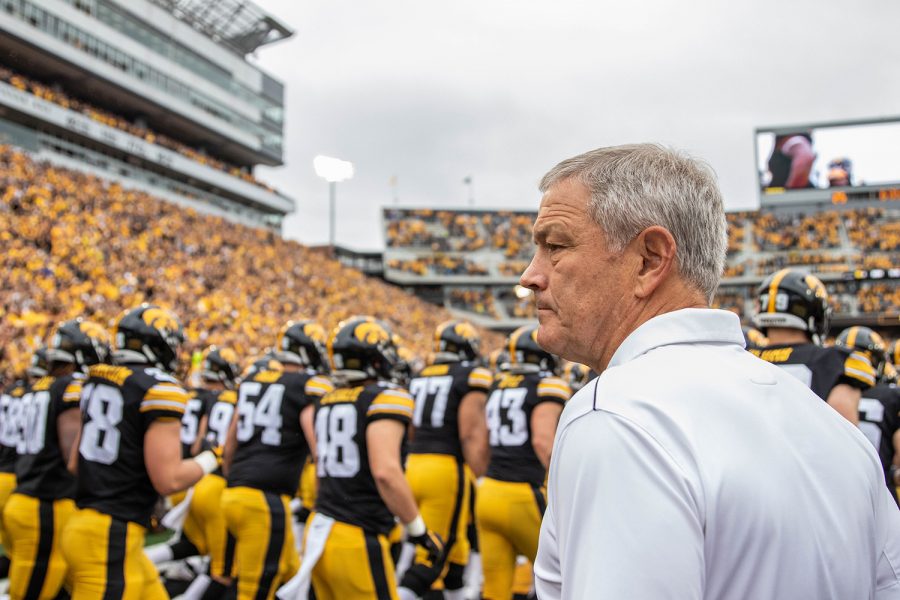Looking back on Iowa football’s 2019 season
A lot of things stood out during Iowa’s 2019 regular season, and they should contribute to the Hawkeyes’ future in a big way.
Iowa head coach Kirk Ferentz watches his players swarm the field before a football game between Iowa and Middle Tennessee State University on Saturday, September 28, 2019. The Hawkeyes defeated the Blue Raiders 48-3.
December 4, 2019
When Iowa dropped back-to-back games against Michigan and Penn State in October, it seemed as if the sky was falling.
That couldn’t have been further from the truth.
Despite losing one more game to Wisconsin in early November, the Hawkeyes battled back to end Minnesota’s perfect season in Kinnick Stadium, proving once again they don’t pack it in once their championship hopes fade.
It’s not easy to keep a team together when the games don’t have postseason implications and the lights aren’t shining bright.
Yet, that’s what Kirk Ferentz and his staff did. Now, Iowa finds itself with a chance for a 10-win season if it leaves its bowl game victorious.
This season produced a lot of positives for the Hawkeyes moving forward.
One of the most important comes in the form of freshman running back Tyler Goodson.
Goodson first burst onto the scene in Iowa’s dominant 48-3 over Middle Tennessee State on Sept. 28. The Suwanee, Georgia, native rushed for 97 yards on 12 carries, dropping hints of what would come.
Against Michigan on Oct. 5, he showed his versatility by leading Iowa with 62 receiving yards in a game in which the offense couldn’t get anything going.
After making his first start against the Gophers and running for 94 yards and a touchdown, he recorded his first 100-yard game against Nebraska in the regular-season finale by posting 116 yards and a score on a 55-yard scamper.
Also on offense came the emergence of the wide-receiver corps.
RELATED: Smith-Marsette changes game with special teams
After a summer that saw Hawkeye fans caught up in Oliver Martin’s transfer from Michigan, Ihmir Smith-Marsette, Brandon Smith, Tyrone Tracy, and Nico Ragaini stole the show.
Smith and Smith-Marsette proved to be the veteran playmakers they needed to be, starting with Smith-Marsette’s two-touchdown performance against Rutgers in Iowa’s second game, while Tracy and Ragaini filled in the cracks.
When Smith went down with an ankle injury against Purdue in the middle of October, Tracy stepped up as a big-play threat. Ragaini also continued his role as quarterback Nate Stanley’s security blanket.
The unit will only grow deeper next season when Martin inevitably takes the field more often (it has to happen, right?).
Add in the versatility Tristan Wirfs produced for the offensive line and the solid play for the majority season by Stanley, the struggles the offense went through to finish drives with touchdowns becomes more difficult to comprehend.
On the defensive side of the ball, preseason All-American defensive end A.J. Epenesa started the year slow before providing a big spark for the Hawkeye defense toward the end of the season.
In the final four games, Epenesa recorded 24 tackles with 5.5 sacks, nine tackles for a loss, and three forced fumbles.
On the back end, cornerback Michael Ojemudia and Geno Stone stepped up in a big way following early injuries to the secondary.
Their level of play through all the turmoil led to All-Big Ten team votes after the season. Ojemudia made the second team as voted by the media, and Stone earned second-team honors from the coaches.
The Hawkeye defense again proved to be one of the best in the country, ranking sixth in the nation in scoring defense by allowing only 13.2 points per game.
While a nine-win season won’t satisfy everyone and there’s room to improve, Iowa won the games it was supposed to win and lost the games people on the outside figured it would lose.
Only five teams have won at least 10 games since Ferentz took over as head coach. If Iowa can pick up one more in its bowl that will be announced on Sunday, it’ll earn another badge of honor.



